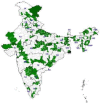India's RMNCH+A Strategy: approach, learnings and limitations
- PMID: 31139464
- PMCID: PMC6509590
- DOI: 10.1136/bmjgh-2018-001162
India's RMNCH+A Strategy: approach, learnings and limitations
Abstract
Building on the gains of the National Health Mission, India's Reproductive, Maternal, Newborn, Child and Adolescent Health (RMNCH+A) Strategy, launched in 2013, was a milestone in the country's health planning. The strategy recognised the interdependence of RMNCH+A Interventions across the life stages and adopted a comprehensive approach to address inequitable distribution of healthcare services for the vulnerable population groups and in poor-performing geographies of the country. Based on innovative approaches and management reforms, like selection of poor-performing districts, prioritisation of high-impact RMNCH+A healthcare interventions, engagement of development partners and institutionalising a concurrent monitoring system the strategy strived to improve efficiency and effectiveness within the public healthcare delivery system of the country. 184 High Priority Districts were identified across the country on a defined set of indicators for implementation of critical RMNCH+A Interventions and a dedicated institutional framework comprising National and State RMNCH+A Units and District Level Monitors supported by the development partners was established to provide technical support to the state and district health departments. Health facilities based on case load and available services across the High Priority Districts were prioritised for strengthening and were monitored by an RMNCH+A Supportive Supervision mechanism to track progress and generate evidence to facilitate actions for strengthening ongoing interventions. The strategy helped develop an integrated systems-based approach to address public health challenges through a comprehensive framework, defined priorities and robust partnerships with the partner agencies. However, lack of a robust monitoring and evaluation framework and sub-optimal focus on social determinants of health possibly limited its overall impact and ability to sustain improvements. Guided by the learnings and limitations, the Government of India has now designed the 'Aspirational Districts Program' to holistically address health challenges in poor-performing districts within the overall sociocultural domain to ensure inclusive and sustained improvements.
Keywords: RMNCH+A; development partners; healthcare service delivery; high priority districts; supportive supervision.
Conflict of interest statement
Competing interests: None declared.
Figures




References
-
- Press Release India’s Call to Action: Child Survival and Development Summit, 7th – 9th February, 2013, Mahabalipuram, Tamil Nadu, Ministry of Health and Family Welfare, Government of India. Available: https://www.who.int/pmnch/media/news/2013/childsurvival_press_release.pdf [Accessed 3 Mar 2019].
-
- Trends in maternal mortality - 1990-2010. WHO, UNICEF, UNFPA and The World Bank Estimates. Geneva Switzerland: World Health Organization; 2012.
-
- Levels and trend in child mortality, report 2012 United Nations Children’s Fund. New York USA; 2012.
Publication types
LinkOut - more resources
Full Text Sources
